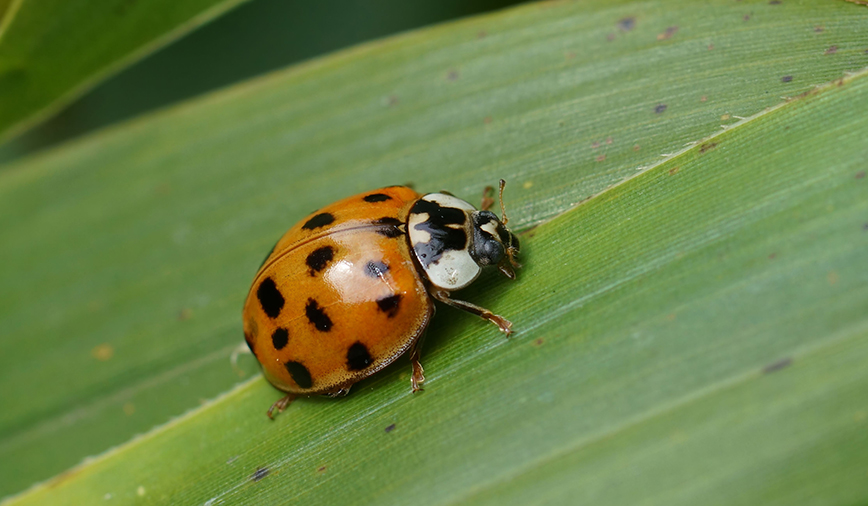October 31, 2014
Multicolored Asian
Lady Beetles
The multicolored Asian lady
beetle is distinguished from native
species by its great numbers, its
highly variable coloration, and a
convenient marking—a dark “M
on the light-colored pronotum,
or shield, that covers the insect’s
head.
Just in case you hadn’t noticed… The bugs are back in town.
Make that the ladybugs. Or, to be more correct, the multicolored Asian lady
beetles, Harmonia axyridis. Pretty from a distance, yet teeming in numbers,
stinky when disturbed and sometimes bitey, these imported insects ain’t no
ladies. Or are they?
Perhaps ill-mannered by our human standards, the multicolored Asian lady
beetle’s habits actually do make sense when taken in context. Their peculiar
smell is related to a defense behavior called reflex bleeding; they release a
small amount of stinky fluid (toxic alkaloids) to deter predators. And their
“bites” aren’t meant to be aggressive; they’re simply one way an MALB
explores its environment. Lastly, their great numbers can be attributed to
their reputation as a beneficial insect; in both their larval and adult stages,
these insects consume large quantities of garden and crop pests.
Although various isolated introductions occurred in the late 1800s, the
imported insect’s “official” history here in the United States dates to 1916,
when the federal government released a shipment of beetles in California
as part of an effort to control aphids and scale insects on nut trees.
Subsequent releases around the country, combined with assorted accidental
introductions, have led to one undeniable fact: MALBs are here to stay.
If you’re reading this near a sunny window ledge, you probably don’t need
me to tell you that.
According to Asian entomologists, MALBs are programmed to migrate
toward “prominent, isolated objects on the horizon” as temperatures cool in
the fall. (Our native species head for the safety of loose bark and leaf litter.)
In the MALB’s homeland, those “prominent, isolated objects” typically are
mountains and cliffs lined with cracks and crevices – excellent places to
crawl in and take a long winter’s nap. But here, our “prominent, isolated
objects” are houses, apartments and offices buildings. And, unless you’re
really good with a caulk gun, your “object” probably has at least a few cracks
and crevices, especially around doors and windows. You may have found you
have more than a few multicolored visitors on your windows, curtains and
walls.
Why have so many shown up this week? According to research conducted
in Ohio, MALB migration as a rule begins the first day temperatures surpass
64F after a period of cooler, near-freezing temps. Last week’s overnight lows
were in the 30s, with daytime highs in the 60s. Then, last Monday, we hit
77F—a temp the ladies found irresistible. At Hickory Knolls, we had MALBs
finding their way inside in droves.
Curiously, they seem to like to congregate beneath a light fixture in the
basement stairwell. Lights on, lights off—it doesn’t seem to matter to these
guys, and gals. Apparently that wall is the perfect “prominent, isolated object”
they’ve been seeking, and their numbers have increased steadily as the week
has gone on.
Their presence has given us a great chance to explore the species in great depth. Here’s what we’ve been able to
glean over the past few days:
• Multicolored Asian lady beetles really do come in a multitude of colors. We have yellow ones, orange ones, red
ones; some with many spots, some with none at all.
• The one trait they do share is the marking on the pronotum—the small shield-like structure that partially covers
the head and thorax. It’s conveniently marked with an “M,” which makes for a great way to distinguish MALBs
from some of our native ladies. (Note: The two-spotted lady beetle, Adalia bipunctata, has a similar, M-shaped
marking, but the center of its “face” is black, while the MALB’s is white.) (Oh, and while you’d think two-spotted
ladybugs would only have two spots, that number can range from zero to 10.)(But I digress…)
• Grass spiders are not interested in eating them.
This last observation came on Thursday, when I thought I’d see if a male grass spider, who’s taken up residence inside
an unused plastic dish in our workroom, might be interested in a lady beetle meal. I dropped the insect into the
spider’s web, and waited. Spider Man (yes, we checked; he’s clearly a male) scuttled out of his lair and headed toward
the ladybug (which may or may not be female, since we aren’t sure how to tell). But then, a few millimeters away from
his quarry, the spider stopped. After a moment or two, he turned around and headed back to his hideout. The MALB,
meanwhile, walked across the non-sticky web and onto the floor; presumably s/he is back on the stairwell wall by
now.
So, spiders-as-agents-of-MALB-control might not be a sound plan. Vacuums, however, are. If you find yourself with
more beetles than you know what to do with, try sucking them up. But be prepared to dispose of the bag, or empty
the receptacle, promptly, since the MALB’s chemical defense can be quite odiferous. Also be careful not to squish
them as you’re cleaning, to avoid releasing the stink, and stain, on your walls and windowsills.
Are you, like me, wondering what MALB’s effects on native ladybug species have been? It would appear that the
diversity among our natives is decreasing. But research is ongoing, since it takes time to identify long-term trends.
One worthy effort is Cornell University’s Lost Ladybug Project, which relies on data submitted by citizen scientists
around the country to track and monitor populations of native ladybug species.
Do you think this program sounds like fun? Get involved! Visit their site, www.lostladybug.org, for more info. Come
next spring, you can let them know when the bugs—the native ones, that is—are back in town.
Pam Otto is the manager of nature programs and interpretive services for the St. Charles Park District. She can be
reached at potto@st-charlesparks.org or 630-513-4346.

